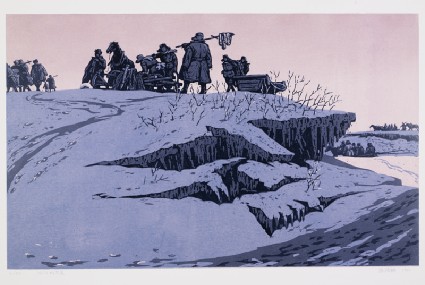Chinese Prints 1950-2006 in the Ashmolean Museum
A catalogue of the Ashmolean’s collection of Chinese prints from 1950-2006 by Weimin He and Shelagh Vainker (published Oxford, 2007).

Publications online: 129 objects
- Reference URL
Actions
Morning by the Frozen River
-
Literature notes
An artist needs to be intoxicated and to dream; being intoxicated implies the indulgence and love of life. Dream is a world that intermingles an artist's aesthetic temperament and the objective world.
Zhang Zhenqi began to create prints in 1951 when he was a member of the art group of the naval section of the People’s Liberation Army. In 1958, along with 100,000 soldiers, Zhang was transferred to state farms in Heilongjiang. Zhang later became one of the key founders of the Great Northern Wilderness Woodcut School. In 1962, he was appointed as a professional printmaker at the Heilongjiang Provincial Artists Association. Using non-key block printing techniques, most of Zhang’s woodcuts depict the life of workers on the farm and the natural scenery in the ‘wasteland’, as well as ethnic minorities in remote areas of China. -
Details
- Associated place
-
Asia › China › Heilongjiang province (subject)
- Date
- 1961
- Artist/maker
-
Zhang Zhenqi (born 1934) (printmaker)
- Material and technique
- multi-block woodcut, printed with oil-based ink
- Dimensions
-
sheet 50 x 75 cm (height x width)
print 36 x 60 cm (height x width)
- Material index
- Technique index
- Object type index
- No. of items
- 1
- Credit line
- Purchased, 2007.
- Accession no.
- EA2007.78
-
Further reading
Weimin He, and Shelagh Vainker, Chinese Prints 1950-2006 in the Ashmolean Museum (Oxford: Ashmolean Museum, 2007), no. 35 on p. 43, illus. p. 43
Location
-
- currently in research collection
Objects are sometimes moved to a different location. Our object location data is usually updated on a monthly basis. Contact the Jameel Study Centre if you are planning to visit the museum to see a particular object on display, or would like to arrange an appointment to see an object in our reserve collections.
Publications online
-

Chinese Prints 1950-2006 in the Ashmolean Museum
An artist needs to be intoxicated and to dream; being intoxicated implies the indulgence and love of life. Dream is a world that intermingles an artist's aesthetic temperament and the objective world.
Zhang Zhenqi began to create prints in 1951 when he was a member of the art group of the naval section of the People’s Liberation Army. In 1958, along with 100,000 soldiers, Zhang was transferred to state farms in Heilongjiang. Zhang later became one of the key founders of the Great Northern Wilderness Woodcut School. In 1962, he was appointed as a professional printmaker at the Heilongjiang Provincial Artists Association. Using non-key block printing techniques, most of Zhang’s woodcuts depict the life of workers on the farm and the natural scenery in the ‘wasteland’, as well as ethnic minorities in remote areas of China.
Notice
Object information may not accurately reflect the actual contents of the original publication, since our online objects contain current information held in our collections database. Click on 'buy this publication' to purchase printed versions of our online publications, where available, or contact the Jameel Study Centre to arrange access to books on our collections that are now out of print.
© 2013 University of Oxford - Ashmolean Museum

